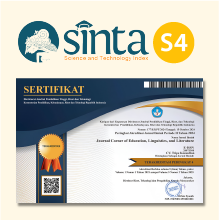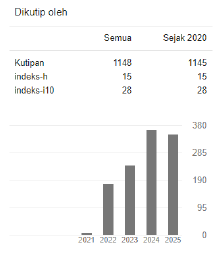Diglossia as a Symbolic Capital in Bangladesh: A Bourdieun Analysis
 https://doi.org/10.54012/jcell.v2i2.71
https://doi.org/10.54012/jcell.v2i2.71
 Abstract views: 891
Abstract views: 891
 PDF downloads: 454
PDF downloads: 454
Keywords:
analysis, Bangladesh, diglossia, Pierre Bourdieu, symbolic capitalAbstract
French sociologist and public intellectual, Pierre Bourdieu’s (1930-2002) Linguistic Capital, one of his Symbolic Capitals, vividly connects with the reality and motto of the use of diglossia in Bangla language. Concurrently, this study seeks to analyze the Bangladeshis’ use of various forms of diglossia in the light of Bourdieu’s symbolic capital. It aims to elaborate how the diglossic forms of Bangla language are shaped as per both the Bangladeshi speaker’s and listener’s symbolic capitals – social capital, cultural capital, and linguistic capital; how language form reveals one’s whole power, position, status and money in the society; and how, in Bangladesh, the differences in a person’s general behavioral pattern or assumptions toward other persons about their social position can be spotted through the use of diglossia of Bangla language. The study applied a simple random sampling to conduct a survey on 50 Bangladeshis aging 18-50 years from across the country. It used the qualitative research methodology which utilized a semi-structured questionnaire to collect data, and it analysed the collected data through coding, categorizing, and percentile representations. The findings offer integral affiliations between the use of diglossia and capitalistic considerations mostly symbolical ones.
Downloads
References
Awal, A. (2021). The Linguistic Debate in Bangladesh throughout History: A Sociolinguistic Perspective. Galaxy International Interdisciplinary Research Journal, 9 (11), 48-59.
Bourdieu, P. and Wacquant, L. (2013). Symbolic capital and social classes. Journal of Classical Sociology.13 (2), 294. http://jcs.sagepub.com/content/13/2/292
Bourdieu, P. (2005). The social structure of the economy. Cambridge: Polity Press.
Bourdieu, P. (1992). Language and symbolic power. Cambridge, MA: Harvard University Press.
Bourdieu, P. (1986). The Forms of Capital. In Richardson, J., Handbook of Theory and Research for the Sociology of Education, pp. 241-258. Westport, CT: Greenwood.
Bourdieu, P. (1984). Distinction: A social critique of the judgment of taste. Cambridge, MA: Harvard University Press.
Bourdieu, P. (1980). The production of belief: Contribution to an economy of symbolic goods. Media, Culture, and Society, 2, 261–293.
Faquire, R. K. (2010). Language Situation in Bangladesh. The Dhaka University Studies, 67 (2),63-77.
Ferguson, C. A. (1959). Diglossia, WORD, 15 (2), 325-340, doi: 10.1080/00437956.1959.11659702
Fishman, J.A. (1972). The Sociology of Language: An Interdisciplinary Social Science Approach to Language in Society. Massachusetts: Newbury House.
Grenfell, M. (2009). Applying Bourdieu's field theory: the case of social capital and education. Education, Knowledge and Economy, 3(1), 17–34. doi:10.1080/17496890902786812
Hossain, M. M. (2022). Longing for Symbolic Capital in Toni Morrison’s The Bluest Eye: A Bourdieun Estimation. Acuity: Journal of English Language Pedagogy, Literature and Culture, 7 (2), 275-295. https://doi.org/10.35974/acuity.v7i2.2777
Hudson, A. (1992). Diglossia: A bibliographic review. Language in Society, 21(4), 611-674. doi:10.1017/S004740450001575X
Ihlen, O.(2018). Symbolic Capital. The international encyclopedia of strategic communication.DOI:http://dx.doi.org/10.1002/9781119010722.iesc0190
Jourdain, A. (2015). Analysing the Symbolic Economy with Pierre Bourdieu: The World of Crafts. Forum for Social Economics, (), 1–20. doi:10.1080/07360932.2015.1075895
Knoll, A.; Jaeger, U. (2019). Lost in diglossia? (Un-)doing difference by dealing with language variations in Swiss kindergartens. Ethnography and Education, (), 1–16. doi:10.1080/17457823.2019.1573692
Lebaron, F. (2014). Symbolic Capital. In: Michalos A.C. (eds) Encyclopedia of Quality of Life and Well-Being Research. Springer, Dordrecht. https://doi.org/10.1007/978-94-007-0753-5_2961
Mooney, A. and Evans, B. (2019). Language, Class and Symbolic Capital. Language, Society and Power an Introduction. (pp-208-228). Routledge.
Moto, F. (2013) Language, Power and Society. Language Matters, 44 (3), 149-152, DOI: 10.1080/10228195.2013.838989
Mu’in, F. (Ed.). (2019). Sociolinguistics: A Language Study in Sociocultural Perspectives. Jurusan Pendidikan Bahasa dan Seni, Fakultas Keguruan dan Ilmu Pendidikan, Universitas Lambung Mangkurat Banjarmasin.
Oakes, L. (2013). Beyond diglossia? Language attitudes and identity in Reunion. Journal of Multilingual and Multicultural Development, 34(1), 30–45. doi:10.1080/01434632.2012.697466
Rahman, A. (2014). The Influence of Social Classes on Language Variations: A Study on the people of Dhaka city, doi: http://hdl.handle.net/10361/3551
Saxena, M. (2014). “Critical diglossia” and “lifestyle diglossia”: development and the interaction between multilingualism, cultural diversity and English. DeGyurter Mounton. DOI:225: 94-95DOI 10.1515/ijsl-2013-0067
Sayahi, L. (2007). Diglossia and Contact-induced Language Change. International Journal of Multilingualism, 4 (1), 38-51, DOI: 10.2167/ijm046.0
Schiffman, H. F. (2017). Diglossia as a Sociolinguistic Situation. In Coulmas, F. (Ed), The Handbook of Sociolinguistics. Blackwell. DOI:10.1002/9781405166256.
Singh, S. (2003). Simple Random Sampling. In: Advanced Sampling Theory with
Applications. Springer, Dordrecht. https://doi.org/10.1007/978-94-007-0789-4_2
Snell, J. (2014). Social Class and Language. http://www.snell.me.uk/wp-content/uploads/HoP-Snell_-Social-class-and-language_updated_changes-accepted.pdf
Toledo, A., Fikkema, R. & Toledo-Pereya, L. (2011). Developing the Research Hypothesis. Journal of Investigative Survey, 24 (5), 191-194. https://doi.org/10.3109/08941939.2011.609449
Wilce, J. (no date) Diglossia, religion, and ideology: On the mystification of cross-cutting aspects of Bengali language variation. Northern Arizona University. https://www.lib.uchicago.edu/e/su/southasia/TESTold/James.1.html
Downloads
Published
How to Cite
Issue
Section
License
Copyright (c) 2022 Md. Mozaffor Hossain, Kaniz Fatema

This work is licensed under a Creative Commons Attribution-ShareAlike 4.0 International License.
All articles published in the Journal Corner of Education, Linguistics, and Literature are licensed under the Creative Commons Attribution-ShareAlike License (CC BY-SA).

















